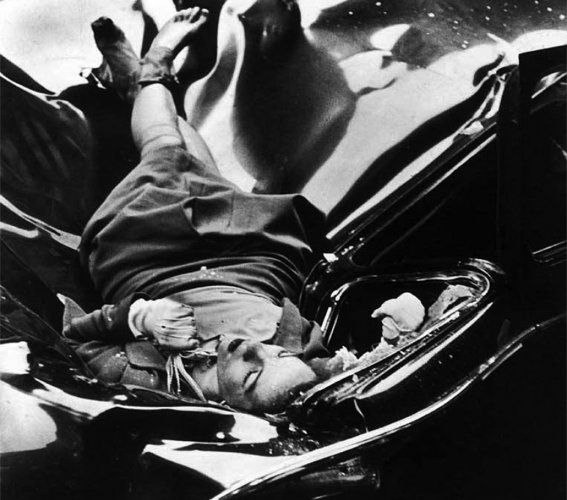Things you should know about Evelyn McHale, the most famous suicide ever
On May 12, 1947, LIFE magazine came out with a photo of Evelyn McHale destined to make a lot of talk about itself.
It was shot on May 1 of the same year by Robert C. Wiles, a novice photographer and portrays a woman, Evelyn McHale, who had just committed suicide, jumping from the panoramic terrace of the Empire State Building, the symbol of New York. We are on 33rd Street, the morning is calm and quiet, people are walking in a hurry, each heading towards their destination, when, in front of the Empire State Building, the sound of twisted metal was heard. People looked towards the street, imagining they were seeing an accident, but instead everyone's attention was drawn to a dark limousine, parked under the Empire Stata Building, and on its roof, which appeared to be broken down. Among the twisted metal sheets, the intact body of a woman. Evelyn Mchale, the woman who fell from heaven.
As mentioned, among the people who witnessed the tragedy that morning, there was also the young Robert, who decided to "seize the moment" by immortalizing the woman's body between the metal sheets, creating a shot that became a true myth.
Who was the beautiful suicide? Evelyn McHale, who at 23 decided, on May 1, 1947, to throw herself from the 86th floor of the iconic skyscraper of New York, ending her life. She threw herself from the last terrace of the skyscraper, before the famous "spike" made famous by King Kong. On the ground, near the low balustrade (too low to be really safe, someone will say later) were found his personal items, the ticket he had bought that morning to go up to the Empire State Building and two letters, one addressed to fiancé, and betrothed, Barry Rhodes, and one to whoever found the body. Long premeditated suicide, then.
Advertisement
But what prompted a young woman, in her prime, about to get married, to commit suicide?
EVELYN MCHALE STORY
First of all, it must be said that Evelyn did not have an easy childhood. Born in 1923, sixth of the nine children of Helen and Vincent McHale, she was forced to move very frequently due to the work of her father, who was a bank examiner. This constant move from city to city also exasperated Evelyn's mother who, at one point, when her husband feared the possibility of moving back to Washington, she filed for divorce, abandoning her husband with her nine children. Evelyn will never forgive her mother for abandoning the entire family for not being able to adapt to her husband's needs.
Vincent McHale takes his nine children and they all move to New York together. Evelyn begins studying and, after graduation, she joins the women's army. She then she moves to Jefferson, Missouri. Her military career does not take off, and Evelyn vents her anger by even burning her uniform.
So she Evelyn returns to New York, a guest of her brother and wife on Long Island. Here she finds a job as an accountant at the Kitab Engraving Company in Pearl Street, Manhattan, and here she meets a guy named Barry Rhodes, who is studying at a college in Easton, Pennsylvania after a stint at the United States Army Air Force.
The relationship between the two is going well, and Evelyn often goes to visit her boyfriend, who is about an hour and a half from New York.
One day, Barry's brother gets married, and Evelyn is asked to be bridesmaid… Evelyn at first accepts, then, in a fit of madness, she burns her bridesmaid dress screaming “I don't want to see him anymore! ". Barry doesn't give much thought to what happened, assuming that his girlfriend is just very stressed, and needs a rest.
Evelyn also spends with her boyfriend on April 30, 1947, the day Barry turns 24. Remember this date. April 30, 1947.
Barry and Evelyn have a pleasant day, and when her boyfriend finally drives her home, she seems excited about her upcoming wedding.
Barry will remember that day like this:
"When I kissed her to greet her, she was happy and normal like any girl about to get married."
Evelyn arrives in New York when it is almost dark. She rents a room at the Governor Clinton Hotel on 31st Street. it is probably in this hotel room that the most dramatic thought of her makes its way into the girl's mind. Perhaps it is in this room that she writes the two farewell letters, puts them in her purse. She then she goes to sleep. It is said that the night brings advice, but what advice did the voices of the night bring to poor Evelyn?

At 10.30 the next morning he leaves the hotel and heads for the Empire State Building. The skyscraper is the symbolic building of New York, many people flock to it from the first light of day, interested in visiting the panoramic terrace from which you can admire all of New York from above.
Evelyn, like other men and women that day, buys the ticket for the panoramic view and goes up to the 86th floor. Here she takes off her coat, folds it diligently, puts it on the ground together with her handbag, approaches the balustrade, which is very low, and ... lets herself fall into the void.
The rest is known history, documented by photography. Evelyn's only letters remain.
Here is what she writes in that of her addressed to her boyfriend Barry:
‘He is much better off without me … I wouldn’t make a good wife for anybody,’
And in the one addressed to whoever found her body:
“I don’t want anyone in or out of my family to see any part of me,” the note read. “Could you destroy my body by cremation? I beg of you and my family – don’t have any service for me or remembrance for me. My fiance asked me to marry him in June. I don’t think I would make a good wife for anybody. He is much better off without me. Tell my father, I have too many of my mother’s tendencies.”
Well, perhaps this is precisely the crux of the fact: that Evelyn was afraid of becoming like her mother, of letting herself go into a rage for no reason and of ending, perhaps, by abandoning her husband for futile reasons as did her own parent. Could the suicide have been intended by the girl as an extreme attempt to avoid falling into this possibility?
Or, much more simply, was the girl really under pressure, she let herself go into depressive fits and she found no other way out than suicide?
Unfortunately, no one will ever be able to answer these questions. Other people, after Evelyn, committed suicide by jumping off the Empire State Building, and Evelyn's on the fifth suicide in three weeks. Only later did the owners of the skyscraper finally decide to raise the balustrade of the 86th floor terrace ... but in the meantime, other deaths had been reaped by the Empire. Since its construction in 1931, the Empire State Building has so far counted 36 suicides, of which 17 occurred from the vantage point on the 86th floor.
Surely, the image of dead Evelyn, in an almost absurd beauty for a person who threw herself from the 86th floor of a skyscraper, did not go unnoticed. She became almost an icon, so much so that Andy Warhol used her to reproduce her countless times, as it is in her style, in his famous "Fallen Body", one of the paintings in the series "Death and Disaster" (1962 -67).


